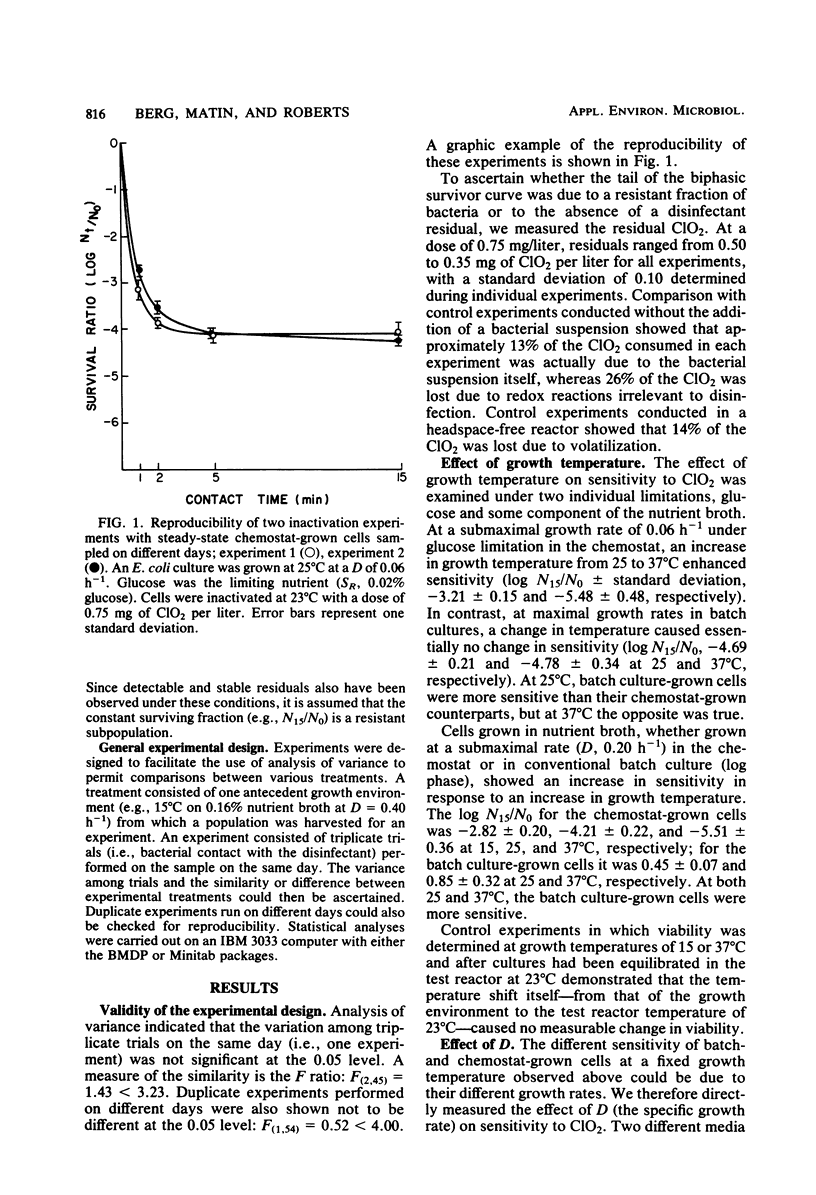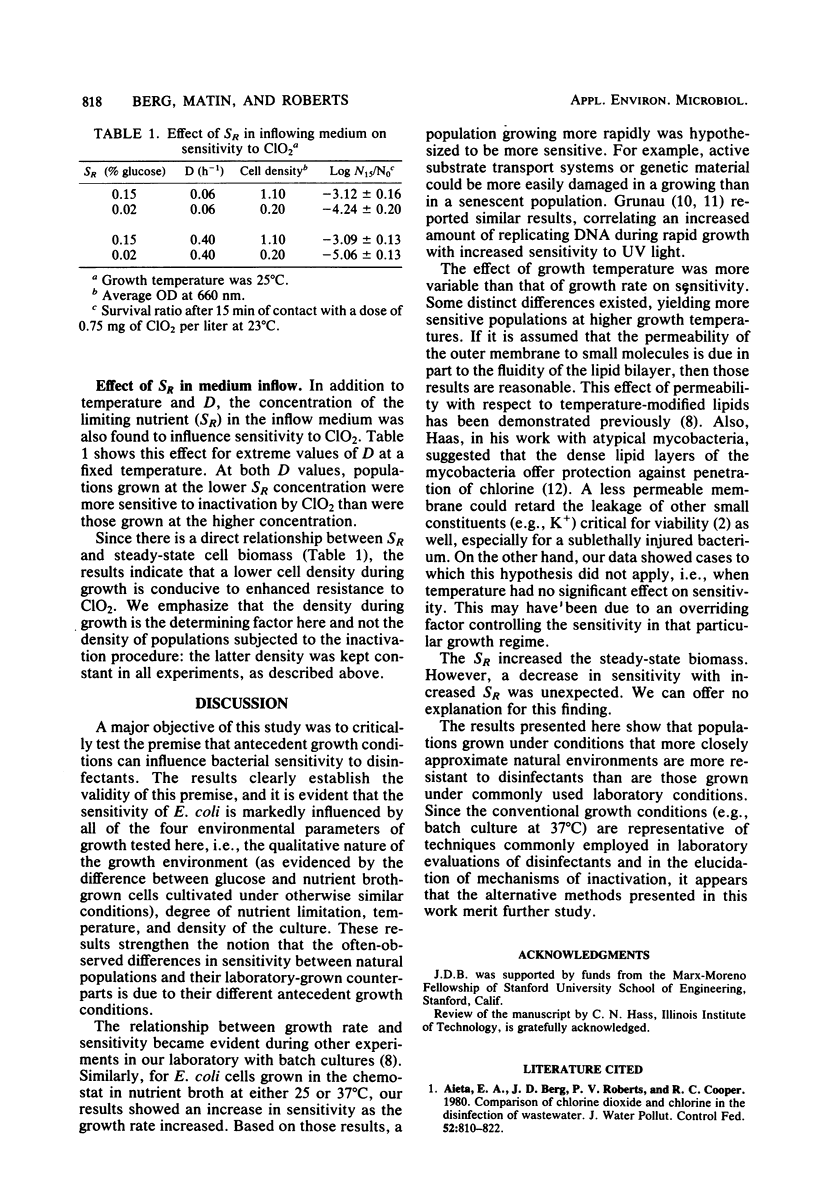Abstract
Bacterial resistance to inactivation by antibacterial agents that is induced by the growth environment was studied. Escherichia coli was grown in batch culture and in a chemostat, and the following parameters were varied: type of substrate, growth rate, temperature, and cell density during growth. Low doses (0.75 mg/liter) of chlorine dioxide were used to inactivate the cultures. The results demonstrated that populations grown under conditions that more closely approximated natural aquatic environments were more resistant than those grown under commonly employed batch culture conditions. In particular, bacteria grown at submaximal rates were more resistant than their counterparts grown at mumax. The most resistant populations encountered in this study were those grown at D values of 0.02 h-1 and 0.06 h-1 at 25 degrees C. Growth at 15 degrees C led to greater resistance than did growth at 37 degrees C. The conditions that produced relatively resistant phenotypes were much closer to those found in most natural environments than are the typical conditions of batch culture methods. The importance of major physiological changes that can be induced by the antecedent growth environment is discussed in light of the possible modes of action of several disinfectants.
Full text
PDF





Selected References
These references are in PubMed. This may not be the complete list of references from this article.
- Aieta E. M., Berg J. D., Roberts P. V., Cooper R. C. Comparison of chlorine dioxide and chlorine in wastewater disinfection. J Water Pollut Control Fed. 1980 Apr;52(4):810–824. [PubMed] [Google Scholar]
- Brock T. D. Microbial growth rates in nature. Bacteriol Rev. 1971 Mar;35(1):39–58. doi: 10.1128/br.35.1.39-58.1971. [DOI] [PMC free article] [PubMed] [Google Scholar]
- Carson L. A., Favero M. S., Bond W. W., Petersen N. J. Factors affecting comparative resistance of naturally occurring and subcultured Pseudomonas aeruginosa to disinfectants. Appl Microbiol. 1972 May;23(5):863–869. doi: 10.1128/am.23.5.863-869.1972. [DOI] [PMC free article] [PubMed] [Google Scholar]
- Carson L. A., Petersen N. J., Favero M. S., Aguero S. M. Growth characteristics of atypical mycobacteria in water and their comparative resistance to disinfectants. Appl Environ Microbiol. 1978 Dec;36(6):839–846. doi: 10.1128/aem.36.6.839-846.1978. [DOI] [PMC free article] [PubMed] [Google Scholar]
- Favero M. S., Drake C. H. Factors influencing the occurrence of high numbers of iodine-resistant bacteria in iodinated swimming pools. Appl Microbiol. 1966 Jul;14(4):627–635. doi: 10.1128/am.14.4.627-635.1966. [DOI] [PMC free article] [PubMed] [Google Scholar]
- Gill C. O., Suisted J. R. The effects of temperature and growth rate on the proportion of unsaturated fatty acids in bacterial lipids. J Gen Microbiol. 1978 Jan;104(1):31–36. doi: 10.1099/00221287-104-1-31. [DOI] [PubMed] [Google Scholar]
- Grieble H. G., Colton F. R., Bird T. J., Toigo A., Griffith L. G. Fine-particle humidifiers. Source of Pseudomonas aeruginosa infections in a respiratory-disease unit. N Engl J Med. 1970 Mar 5;282(10):531–535. doi: 10.1056/NEJM197003052821003. [DOI] [PubMed] [Google Scholar]
- Haas C. N., Engelbrecht R. S. Physiological alterations of vegetative microorganisms resulting form chlorination. J Water Pollut Control Fed. 1980 Jul;52(7):1976–1989. [PubMed] [Google Scholar]
- Jannasch H. W. Estimations of bacterial growth rates in natural waters. J Bacteriol. 1969 Jul;99(1):156–160. doi: 10.1128/jb.99.1.156-160.1969. [DOI] [PMC free article] [PubMed] [Google Scholar]
- Lambert P. A., Hammond S. M. Potassium fluxes, first indications of membrane damage in micro-organisms. Biochem Biophys Res Commun. 1973 Sep 18;54(2):796–799. doi: 10.1016/0006-291x(73)91494-0. [DOI] [PubMed] [Google Scholar]
- MILBAUER R., GROSSOWICZ N. Effect of growth conditions on chlorine sensitivity of Escherichia coli. Appl Microbiol. 1959 Mar;7(2):71–74. doi: 10.1128/am.7.2.71-74.1959. [DOI] [PMC free article] [PubMed] [Google Scholar]
- Matin A., Grootjans A., Hogenhuis H. Influence of dilution rate on enzymes of intermediary metabolism in two freshwater bacteria grown in continuous culture. J Gen Microbiol. 1976 Jun;94(2):323–332. doi: 10.1099/00221287-94-2-323. [DOI] [PubMed] [Google Scholar]
- Matin A., Veldkamp H. Physiological basis of the selective advantage of a Spirillum sp. in a carbon-limited environment. J Gen Microbiol. 1978 Apr;105(2):187–197. doi: 10.1099/00221287-105-2-187. [DOI] [PubMed] [Google Scholar]
- Niekus H. G., de Vries W., Stouthamer A. H. The effect of different dissolved oxygen tensions on growth and enzyme activities of Campylobacter sputorum subspecies bubulus. J Gen Microbiol. 1977 Dec;103(2):215–222. doi: 10.1099/00221287-103-2-215. [DOI] [PubMed] [Google Scholar]
- Seidler R. J., Morrow J. E., Bagley S. T. Klebsielleae in drinking water emanating from redwood tanks. Appl Environ Microbiol. 1977 Apr;33(4):893–900. doi: 10.1128/aem.33.4.893-900.1977. [DOI] [PMC free article] [PubMed] [Google Scholar]
- Skaliy P., McEachern H. V. Survival of the Legionnaires' disease bacterium in water. Ann Intern Med. 1979 Apr;90(4):662–663. doi: 10.7326/0003-4819-90-4-662. [DOI] [PubMed] [Google Scholar]
- Skaliy P., Thompson T. A., Gorman G. W., Morris G. K., McEachern H. V., Mackel D. C. Laboratory studies of disinfectants against Legionella pneumophila. Appl Environ Microbiol. 1980 Oct;40(4):697–700. doi: 10.1128/aem.40.4.697-700.1980. [DOI] [PMC free article] [PubMed] [Google Scholar]
- VISHNIAC W., SANTER M. The thiobacilli. Bacteriol Rev. 1957 Sep;21(3):195–213. doi: 10.1128/br.21.3.195-213.1957. [DOI] [PMC free article] [PubMed] [Google Scholar]


